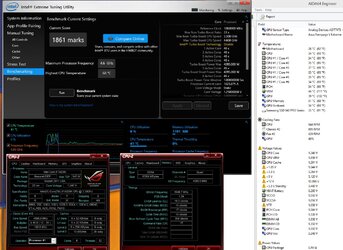- Joined
- Jan 12, 2015
*Edit* I have solved the problem. See the 4th post in this thread for details.
Hi guys. Long time system builder and OC'er (nearly two thousand under my belt), so not a newb.
However with this X99-A I seem to be a little stuck when it comes to CPU voltages. I do not use the OC software, I am old school and software OC seems, I don't know, sac-religious I guess.
Anyways, to start with the system I am currently working with is:
Asus X99-A
HyperX 16GB DDR4 3000 Model HX430C15PB2K4/16 @ 3GHz (BCLK @125MHz)
i7 5820K @4.375 GHZ (idle @ 30 degrees C, 2 hours Prime 95 small FFT 80 degrees C)
Cooler Master Nepton 240 watercooler
EVGA 04G-P4-3975-KR GeForce GTX 970 4GB
Creative Sound Blaster Zx
SAMSUNG 850 Pro 256GB SSD
CORSAIR HX650 PSU
Cooler Master HAF XB EVO Case
Multiple Terabytes of SATA HDD's
Rock solid stable!
I built this system last week, and it runs flawless.
However, when letting the motherboard "auto" control the CPU voltage (VID) it runs at 1.28v (a little high for my taste). I also have a Maximus VII Hero with 4790k @4.6 and was able to get it running that way with only 1.20V (motherboard auto).
The problem:
I was unable to find any way to limit the maximum CPU VID on the X99-A. So instead, by trial and error, I figured out the minimum voltage that this overclock would run stable with and set it there manually in the BIOS. The obvious downside it that even at system idle the CPU is running 1.15V, when it COULD be running at about 0.95V.
So, here goes the question:
Is there a way to manually set a "range" of voltages for the CPU (and CPU Cache) on the X99-A?
Example: I would like to have the CPU VID and Cache run between 0.95V (idle) and 1.15V (full load).
The obvious reason I would like it this way is heat. While the water block does keep it at 30C idle, it has the fans (and pump) running faster than necessary to do so.
What I have tried:
1: Using the offsets - invariably causes no-POST. I believe this is because offsets do not offer +- simultaneously, it is either + or -
2: Tuning the LLC (External). It runs at 1.27V even on Level 1.
A bunch of other stuff, I do not recall everything, but what I am looking for is someone who can tell me how to set a usable "range" of CPU voltages (without causing it to drop too low and crash).
Thanks for any help you can offer.
Hi guys. Long time system builder and OC'er (nearly two thousand under my belt), so not a newb.
However with this X99-A I seem to be a little stuck when it comes to CPU voltages. I do not use the OC software, I am old school and software OC seems, I don't know, sac-religious I guess.
Anyways, to start with the system I am currently working with is:
Asus X99-A
HyperX 16GB DDR4 3000 Model HX430C15PB2K4/16 @ 3GHz (BCLK @125MHz)
i7 5820K @4.375 GHZ (idle @ 30 degrees C, 2 hours Prime 95 small FFT 80 degrees C)
Cooler Master Nepton 240 watercooler
EVGA 04G-P4-3975-KR GeForce GTX 970 4GB
Creative Sound Blaster Zx
SAMSUNG 850 Pro 256GB SSD
CORSAIR HX650 PSU
Cooler Master HAF XB EVO Case
Multiple Terabytes of SATA HDD's
Rock solid stable!
I built this system last week, and it runs flawless.
However, when letting the motherboard "auto" control the CPU voltage (VID) it runs at 1.28v (a little high for my taste). I also have a Maximus VII Hero with 4790k @4.6 and was able to get it running that way with only 1.20V (motherboard auto).
The problem:
I was unable to find any way to limit the maximum CPU VID on the X99-A. So instead, by trial and error, I figured out the minimum voltage that this overclock would run stable with and set it there manually in the BIOS. The obvious downside it that even at system idle the CPU is running 1.15V, when it COULD be running at about 0.95V.
So, here goes the question:
Is there a way to manually set a "range" of voltages for the CPU (and CPU Cache) on the X99-A?
Example: I would like to have the CPU VID and Cache run between 0.95V (idle) and 1.15V (full load).
The obvious reason I would like it this way is heat. While the water block does keep it at 30C idle, it has the fans (and pump) running faster than necessary to do so.
What I have tried:
1: Using the offsets - invariably causes no-POST. I believe this is because offsets do not offer +- simultaneously, it is either + or -
2: Tuning the LLC (External). It runs at 1.27V even on Level 1.
A bunch of other stuff, I do not recall everything, but what I am looking for is someone who can tell me how to set a usable "range" of CPU voltages (without causing it to drop too low and crash).
Thanks for any help you can offer.
Last edited:
 to the OCF
to the OCF

